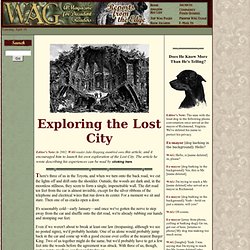

On the Non-Complete: On the Non-Complete in Visionary Architecture - Amos Bar-Eli. Houses Gone Wild. We think of feral dogs as dangerous, foreboding and to-be-avoid – but wild houses have a strange allure despite (or likely because) they are abandoned abodes, deserted homes gone from domestic spaces slowly back to nature.

As photographer James D Griffioen muses, the Latin root refers both to while beasts but also to something that belongs to the dead, gone back to the Earth. WAG: Elko Tract: Exploring the Lost City. There's three of us in the Toyota, and when we turn onto the back road, we cut the lights off and drift onto the shoulder.

Outside, the woods are dark and, in the moonless stillness, they seem to form a single, impenetrable wall. The dirt road ten feet from the car is almost invisible, except for the silver ribbons of the telephone and electrical wires that run down its center. For a moment we sit and stare. Then one of us cracks open a door. It's seasonably cold—early January—and once we've gotten the nerve to step away from the car and shuffle onto the dirt road, we're already rubbing our hands and stomping our feet. Even if we weren't about to break at least one law (trespassing, although we see no posted signs), we'd probably hesitate. Unfinished work.
An unfinished work is creative work that has not been finished. Its creator may have chosen never to finish it or may have been prevented from doing so by circumstances outside of their control, such as death. Such pieces are often the subject of speculation as to what the finished piece would have been like; sometimes they are finished by others and released posthumously. Unfinished works have had profound influences on their genres and have inspired others in their own projects.
The Process of Artistic Creation in Terms of the Non-finito. Jeremy Angier May 07, 2001 New York Academy of Art The Process of Artistic Creation in Terms of the Non-finito If Michelangelo had not been born, would it have been necessary to invent him? There have been countless times in human history when a "solitary genius," seemingly working in isolation or outside the common run of contemporary society, has derived for posterity a revolutionary mode of being.
In limited retrospect, this character has apparently invented out of thin air a solution to the most pressing issues of the day; he has risen to the impasse facing his generation and led human history from darkness into the light. I say 'limited retrospect' because in full retrospect we see that history could have taken no other path than the one it has taken, and in fact the genius with the solution did not really invent anything original, he simply found a means of voicing what was on the tip of everyone's tongue.
Yet Michelangelo insisted upon sculpture as the most noble enterprise. Non finito. Non finito is a sculpting technique literally meaning that the work is unfinished.

Non finito sculptures appear unfinished because the artist only sculpts part of the block, leaving the figure appearing to be stuck within the block of material. Unfinished Italy Documentary - unfinished-italy.com. Unfinished building. The Szkieletor remains unfinished because it would be too costly to complete or demolish. An unfinished building is a building (or other architectural structure, as a bridge, a road or a tower) where construction work was abandoned or on-hold at some stage or only exists as a design.
It may also refer to buildings that are currently being built, particularly those that have been delayed or at which construction work progresses extremely slowly. Many construction or engineering projects have remained unfinished at various stages of development. Folly. In architecture, a folly is a building constructed primarily for decoration, but either suggesting by its appearance some other purpose, or merely so extravagant that it transcends the normal range of garden ornaments or other class of building to which it belongs.

In the original use of the word, these buildings had no other use, but from the 19th to 20th centuries the term was also applied to highly decorative buildings which had secondary practical functions such as housing, sheltering or business use. [dubious ] 18th century English gardens and French landscape gardening often featured Roman temples, which symbolized classical virtues or ideals. Other 18th-century garden follies represented Chinese temples, Egyptian pyramids, ruined abbeys, or Tatar tents, to represent different continents or historical eras. Characteristics[edit] General properties[edit] What follies are not[edit] Fantasy and novelty buildings are essentially the converse of follies. History[edit] Famine follies[edit] City Visions Europe - Interview with Ines Weizman. Eine von Europas bekanntesten und kreativsten Metropolen ist ohne Zweifel London.

Die Stadt ist berühmt für ihre unzähligen Geschäfte und Läden, die sich je nach ihrer Art in verschiedene Viertel verteilen. Abgesehen von den typischen Modehäusern, die zum Einkauf locken, finden sich dort auch einige wunderbar sortierte Secondhand-Shops, in denen man einige Schnäppchen machen kann. Hinsichtlich der Mode ist man dort generell sehr darauf bedacht, sich individuell zu kleiden, daher erklärt sich auch die Tradition solcher Vintage-Läden. Ein eigener Style gehört einfach zum Leben in dieser Stadt- es gibt nichts, das es nicht gibt! Während im Allgemeinen der Stil zwar eher schick ist, begegnet man dennoch immer wieder äußerst exzentrischen Looks in der Innenstadt, in der Trends gesetzt werden. Abgesehen von den vielen Touristen-Attraktionen, Kirchen, Museen, und Shows, die alle einen Besuch wert sind, sollten Sie sich definitiv auch die kleineren Viertel in London anschauen. Notes on incomplete architecture. An On-line Book Draft First Draft Presented at the Congress for the New Urbanism 2000.
